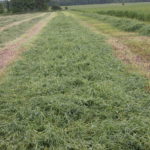
First-cut is still underway, with the first good opportunity to make dry hay without rain-damage the week of June 17th. Lots of propionate hay preservative and plastic wrap is being used. Some wet fields have been badly rutted. Yields are generally good, but maturity is advanced. Grasses are more mature relative to the alfalfa. Second-cut regrowth is excellent on early-cut fields. Many haylage fields received an application of liquid dairy manure. Hay prices have been holding steady to date.
Preventing Mouldy Hay Using Propionate Preservatives https://fieldcropnews.com/?p=3655
Baleage Tips https://fieldcropnews.com/?p=3531)
Remove large hay bales from the field as quickly as possible. Minimizing tractor and wagon traffic before regrowth occurs prevents alfalfa crown damage and subsequent yield loss. The cost of indoor storage is only a small proportion of the total cost of producing hay, and is easily recoverable by maintaining forage quality and minimizing spoilage losses. It is essential that hay storages have adequate ventilation to enable moisture to dissipate from bales. Tightly stacking bales should be avoided. The use of pallets prevents spoilage of the bottom row of bales. Be sure to monitor hay storages for heating. Probe-type hand-held electronic moisture testers are a useful tool to monitor hay heating. However, moisture readings can be subject to variability and error and should be calibrated to forage species, bale type, acid use and bale density. Hay stored outside should be properly covered with bale tarps to shed rain and snow to minimize spoilage losses. Wicking of moisture can be very significant, so use pallets or crushed stone to keep them off the ground. Six inches of spoilage around the outside of a round bale represents 20% of the volume of a 5 foot diameter bale, and 25% of the volume of a 4 foot bale. With high hay prices, this is an expensive loss. (Silo & Hay Fires www.omafra.gov.on.ca/english/engineer/facts/93-025.htm)
Low soil fertility reduces forage yield and persistence. Forages have high P and K removal rates. A tonne of mixed hay removes about 14 lbs P2O5 and 58 lbs of K2O, equivalent to about 2¢ per lb of hay. Without replacement with manure or commercial fertilizer, soil tests will drop quickly. If a soil test is below 120 ppm K, you can expect a yield response from top-dressing potassium. (https://fieldcropnews.com/?p=3760) Nitrogen applied to grassy fields with adequate moisture will increase yields. (https://fieldcropnews.com/?p=6830) Fertilizer and liquid manure should be applied immediately after harvest to minimize wheel traffic damage.